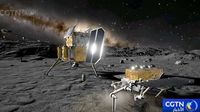China is set to launch its "Chang'e-7" mission in 2026, aimed at exploring the lunar south pole, a region rich in resources and scientific potential. This ambitious project is part of China's ongoing lunar exploration program, which has seen significant progress over the past two decades.
On April 3, 2025, a historic exhibition showcasing lunar samples collected from both the near and far sides of the moon opened at the National Museum of China in Beijing. This exhibition marks the first time such samples have been displayed together and underscores the advancements made in China's lunar exploration efforts. The samples were gathered during the "Chang'e-5" and "Chang'e-6" missions and are part of a broader narrative that began with the official approval of China's lunar exploration program in 2004.
The exhibition, hosted in collaboration with the China National Space Administration, spans two months and includes hundreds of valuable artifacts, photographs, and documents that highlight the historical context, development, and achievements of the program. Organizers aim to provide a comprehensive overview of China's efforts to explore the moon, emphasizing its historical significance and future goals.
As humanity stands on the brink of a new era in space exploration, the conversation around the role of robotics versus human astronauts continues to evolve. Notably, on December 24, 2024, NASA's Parker Solar Probe made headlines by flying closer to the sun than any human-made object before it, reaching temperatures of around 1000 degrees Celsius. This mission, which lasted ten days, was notable for its lack of human intervention, showcasing the capabilities of autonomous technology in extreme environments.
The success of robotic missions raises questions about the necessity of human presence in space exploration. Some experts argue that as robotic technology advances, the rationale for sending humans into space diminishes. Lord Martin Rees, the Astronomer Royal in the UK, posits that the financial resources for manned missions should come from private sectors, suggesting that human space travel could become a luxury adventure for the wealthy rather than a public endeavor.
Professor Andrew Coats from University College London echoes these sentiments, advocating for robotic exploration due to its cost-effectiveness and ability to access remote locations. He emphasizes that as artificial intelligence continues to improve, robots will increasingly take on complex tasks that humans currently perform.
However, the debate remains nuanced. Dr. Kelly Wienersmith, a biologist at Rice University, argues that while robots excel in certain areas, humans bring a unique adaptability and problem-solving capability that machines cannot replicate. She highlights the ongoing need for human presence in space for scientific research and exploration.
Despite the advantages of robotic missions, the challenges of human life in space remain significant. Maintaining life support systems in harsh environments is costly and complex, leading to ongoing discussions about the future of astronauts in space exploration. Samantha Harvey, in her Booker Prize-winning novel "Orbital," poetically describes robots as beings free from human needs, suggesting that their lack of desires makes them ideal for space missions.
Yet, robots face challenges of their own, including slow operational speeds. For example, Mars rovers like Curiosity move at a mere 0.1 miles per hour, which pales in comparison to human capabilities. Dr. Ian Crawford, a planetary scientist, questions whether AI can truly match human intuition and creativity in exploring alien environments, indicating that the answer remains uncertain.
The integration of artificial intelligence in human space missions could ease the burden on astronauts by automating routine tasks. According to Dr. Kiri Wagstaff, a computer scientist at NASA's Jet Propulsion Laboratory, AI can handle repetitive activities, allowing humans to focus on critical scientific research. However, the energy demands of advanced AI systems pose a significant challenge, particularly for missions to distant planets.
Human-like robots, such as NASA's Valkyrie, developed in 2013, exemplify the potential for machines to assist astronauts in complex tasks. Valkyrie is designed to mimic human physical capabilities, enabling it to perform intricate operations in space. NASA's Robonaut, launched to the International Space Station in 2011, was another pioneering effort, tasked with routine maintenance and assembly tasks that previously required human intervention.
Dr. Sean Azimi, a lead robotics researcher at NASA, emphasizes that robots are not meant to replace astronauts but to enhance their capabilities. They can perform vital maintenance tasks autonomously, ensuring the safety and sustainability of human habitats in space.
As robots increasingly operate independently, they make decisions without human input. For instance, the Curiosity rover autonomously conducts scientific experiments, sending valuable data back to Earth. However, the emotional connection humans create during space exploration remains irreplaceable. Professor Coats notes that the inspiration derived from human presence in space is a powerful motivator that robotic missions cannot replicate.
Looking ahead, both NASA and China are gearing up for a renewed focus on human space exploration. NASA's Artemis program aims to return humans to the moon by 2026, with plans for a lunar landing in 2027. Meanwhile, Elon Musk's SpaceX envisions establishing a human settlement on Mars, with the ambitious goal of transporting one million people to the red planet within 20 years using the Starship spacecraft.
Dr. Wienersmith acknowledges the challenges of living on Mars, emphasizing the need for careful consideration of the technical and ethical implications of such endeavors. Lord Rees predicts a future where human and robotic exploration will converge, potentially leading to a new form of humanity adapted to life in space.
In summary, the future of space exploration is likely to be a collaborative effort between humans and machines. While robots will handle hazardous and routine tasks, humans will continue to explore, leveraging their unique skills to push the boundaries of what is possible in the cosmos. With ongoing advancements in technology and AI, the next chapter in space exploration promises to be exciting, opening new frontiers for discovery and understanding.

